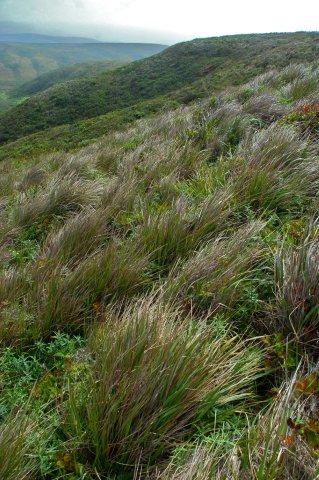Prairie:
Vegetation Types

Pacific reedgrass stand at Point Reyes National Seashore 2010. Photo by J. Coleman.
Like other vegetation types, coastal prairie community types are named after the species in the stand with the most ground cover. In coastal prairie, these species are often perennial or annual grasses. Native perennial grasses most common in coastal prairies of Sonoma and Marin Counties are California oatgrass (Danthonia californica), tufted hairgrass (Deschampsia cespitosa), and Pacific reedgrass (Calamagrostis nutkaensis).
Many vegetation types have not yet been characterized. The Manual of California Vegetation, an on-going effort to quantitatively identify all of the vegetation types throughout California, identified 4 types associated with coastal prairie in the first edition (Sawyer and Keeler-Wolf 1995) and 9 types (associations) in the second edition (Sawyer, et al. 2009). Grasslands are particularly difficult to characterize due to the changing abundance of cover of species over the season. Moreover, the distinction between coastal prairie and valley grasslands is less clear in areas where coastal influences reach inland (Ford and Hayes 2007).
The coastal prairie mapping project conducted by the Coastal Prairie Enhancement Feasibility Study in 2010 and 2011 identified over 34 types of coastal prairie grasslands in Sonoma and Marin Counties, which constitute from 30-50% of the total number of vegetation types in the two counties (CPEFS 2010).
Species composition in coastal prairie tends to vary with landform, each with distinct differences in the occurrence of dominant grass species (Stromberg, et al. 2001). The following is a partial list of the most common coastal prairie vegetation types (or “alliances”) with associated land forms found in Sonoma and Marin counties (Sawyer et al. 2009).
Native Dominated Stands
- Pacific reed grass meadows (Calamagrostis nutkaensis Herbaceous Alliance) can be found in valley bottoms, the lower portions of alluvial slopes, terraces, and coastal bluffs.
- California oat grass prairie (Danthonia californica Herbaceous Alliance) occurs in coastal prairies and wetlands. The alliance can be found on coastal bluffs, valley bottoms, floodplains, terraces, slopes, and ridge tops. Coyote brush (Baccharis pilularis) and other woody plants are encroaching upon these stands along the Northern California Coast. Smaller stands of this alliance are also found in the California interior along the western edges of the Sierra Nevada foothills and in meadows in the Sierra Nevada Mountains.
- Tufted hairgrass meadows (Deschampsia cespitosa Herbaceous Alliance) are distributed on coastal bluffs, terraces, sand dunes, and seasonally flooded areas. The alliance can also be found in mountain to wet alpine meadows in the southern Cascades and Sierra Nevada Ranges.
- Blue wild rye meadows (Elymus glaucus Herbaceous Alliance) occur along the north coast in foothill meadows and elevated flats.
- Idaho fescue grasslands (Festuca idahoensis Herbaceous Alliance) are found on bald hills and serpentine soils along the coast and in many habitats throughout northern California. The non-natives sweet vernal grass (Anthoxanthum odoratum) and common velvet grass (Holcus lanatus) are commonly co-dominant in this alliance on coastal terraces in Mendocino and Sonoma Counties (see Non-native Dominated Stands below).
- Red fescue grasslands (Festuca rubra Herbaceous Alliance) occur on coastal bluffs, headlands, toe slopes, terraces, and sand dunes. Coyote brush (Baccharis pilularis) is encroaching upon these stands in Marin County. In Marin County, purple needle grass (Stipa pulchra, formerly Nassella pulchra) occurs in these grasslands along with other perennial grasses, forbs and shrubs.
Semi-Natural Herbaceous Stands
Sawyer, et al. (2009:1247) describe semi-natural stands as, "Vegetation in which past or present human activities significantly influence composition or structure but do not eliminate or dominate spontaneous ecological processes." The following non-native dominated stands remain valuable in that they can contain a wide variety of native plant species. Futhermore, these grasslands continue to provide important habitat with food, forage, shelter, protection, nesting sites, and hunting grounds for wildlife (Sawyer, et al. 2009).
Common velvet grass-sweet vernal grass meadows (Holcus lanatus-Anthoxanthum odoratum) semi-natural herbaceous stands are dominant or co-dominant along coastal bluffs, terraces and moist pastures. Introduced from Europe, Holcus lanatus populations are increasing in many of California’s coastal prairies including those in Sonoma and Marin Counties.
Bent grass-tall fescue meadows (Agrostis gigantea, A. stolonifera, Festuca arundinacea) semi-natural herbaceous stands are dominant or co-dominant in areas that were once occupied by Pacific reedgrass (Calamagrostis nutkaensis), California oatgrass (Danthonia californica), and tufted hairgrass (Deschampsia cespitosa) alliances.
Annual dogtail grasslands (Cynosurus echinatus)—semi-natural herbaceous stands are dominant or co-dominant with other non-natives in the herbaceous layer. These deteriorated grasslands can contain native plants including California oatgrass (Danthonia californica), blue wild rye (Elymus glaucus), blue-eyed grass (Sisyrinchium bellum), Ithuriel's spear (Triteleia laxa), and other remnants of the pre-invaded community.